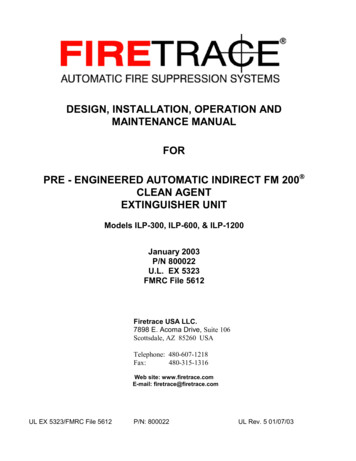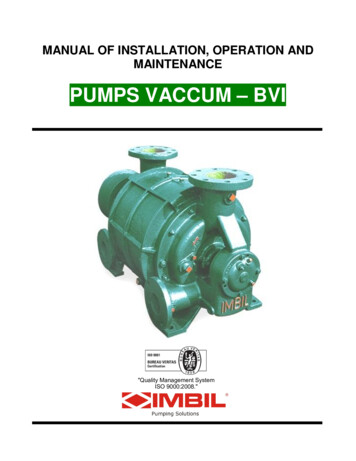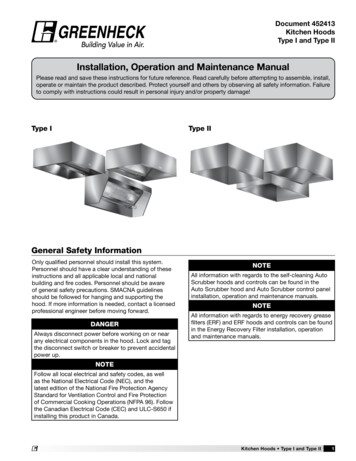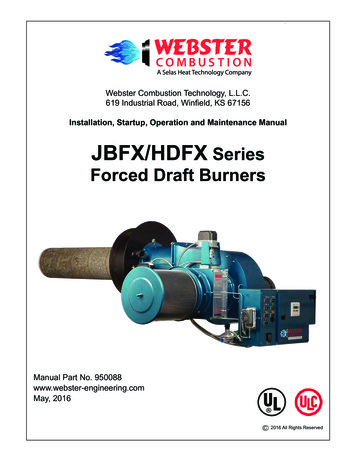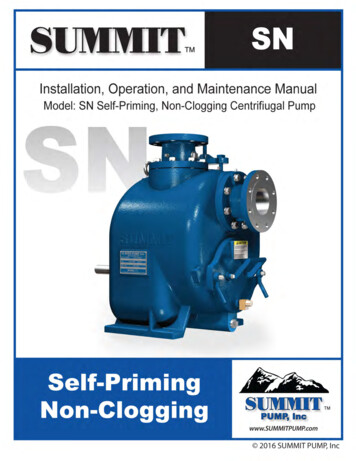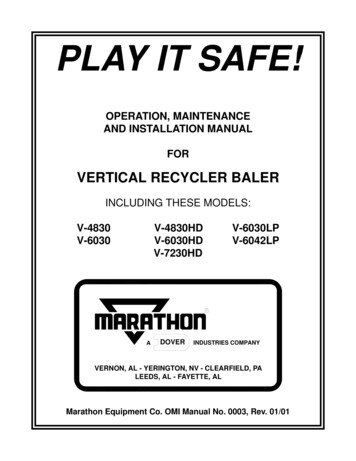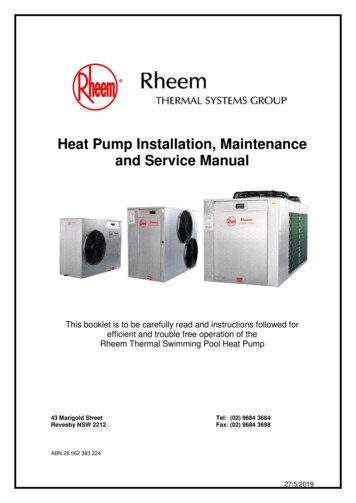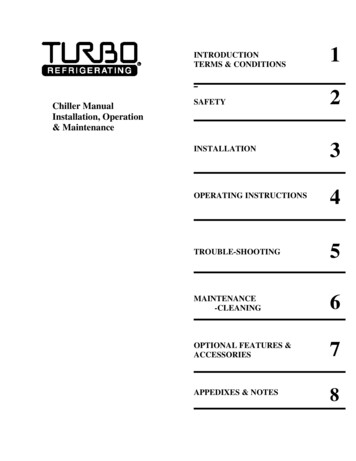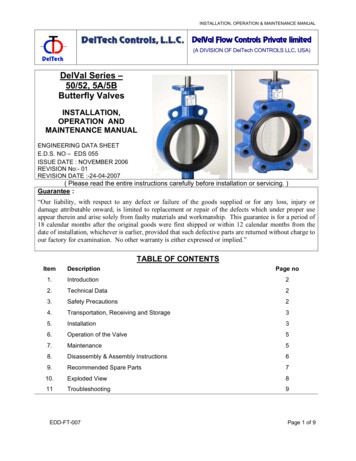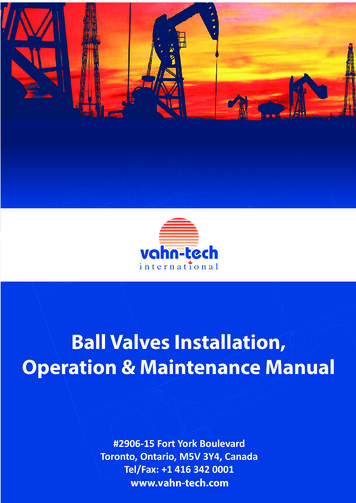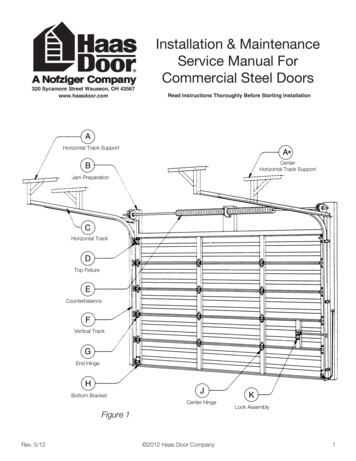
Transcription
TheHeat Tracing AuthorityDesign, Installation andMaintenance ManualIndustrial Electric Heat Tracing SystemsTM
CONTENTSPageSYSTEM DESIGN . 1Introduction; Competence; Thermal Insulation; Selection of Heat Tracer; Site FabricatedHeaters; Maximum Temperature Determination; Inherently Temperature Safe Heat Tracers(PTC Characteristic); Stabilised Design; Controlled Design; Location of Temperature Sensors.INSPECTIONS . 4Receiving Materials; Pre-Installation Testing; Visual Examination; Insulation Resistance Test;Component Substitution; Determination of Power Supply Location;Installation of Heat Tracers; Connections & Terminations; Connection Kits.PRE-INSTALLATION CHECKS . 6Pre-Installation Checks - Table 1; Junction Boxes; Cold Leads; Heat Tracer Entries & Glands;Earthing Requirements; Jointing, Splicing & Modifications; End Terminations;Conductor Terminations.STANDARD CABLE INSTALLATION PROCEDURE . 8Electrical Supply Points; Spiral Pitch; Cable Installation; Cable Fixing; Flanges; Valves;Cable Terminations; Splice Connections; Tee Branches; Plastic Pipework; Sensor Location;Fittings.INSTALLATION PROCEDURE FOR LLR CABLES . 11Electrical Supply Points; Spiral Pitch; Cable Installation; Cable Fixing; Sensor Location;Flanges; Valves; Bending Ratios; Cable Terminations; Electrical Connections;Earthing / BondingCONTROL & MONITORING . 14Verification of Equipment Suitability; Sensor Considerations; General Sensor Installation;Sensor Installation for Temperature Controllers;Sensor Installation for Temperature Limiting Device;Controller Operation, Calibration & AccessTHERMAL INSULATION . 15General (Selection and Application); Preparatory WorkDISTRIBUTION WIRING & BRANCH CIRCUITS . 16Earth Fault Protective Device; Circuit Protective Device; Tagging & IdentificationTESTING . 16Heater Circuit IR Test; Necessary Modifications; Visual InspectionCOMMISSIONING . 17Pre-commissioning Check; Functional Check & Final Documentation; Final Documentation;Testing after Commissioning; Instructions for maintenance/repair or modification;Pre-commissioning Check List; Heater Commissioning RecordCABLE MARKINGS . 20, 21NOTES . 21One page for your notes.May 2020 Issue: 18ii
SYSTEM DESIGNCompetenceIntroductionThe design of electrical resistance traceheating systems shall be overseen by personsknowledgeable of trace heating following thedesign methodology for explosive atmospheres asspecified by the manufacturer.Each heat tracing application imposes uniquedemands on the designer to achieve the desiredperformance in a safe manner. Heat tracing,systems comprise heating cables and ancillaryitems which necessarily interface with othersystem components such as thermal insulation andthe electrical supply items which will power thesystem. The overall system is the integration ofthese component parts and so the values of theseinterfaced items have to be known and controlledin order to design a system that will perform asrequired, and do so safely.Thermal insulationThe selection, installation and maintenance ofthermal insulation is a key component in theperformance of an electrical heat tracing system.The type and thickness of the insulation must beas specified in the design documentation.The thermal insulation system is normally designedto prevent the majority of heat losses. The heattracing system compensates for the remaininglosses. Therefore, problems with thermalinsulation will have a direct impact on the overallsystem performance.Aspects of Safety are regulated by IEC 60519-1,‘Safety in installations for Electroheatingand electromagnetic processing’ – Particularrequirements for electrical resistance traceheating systems for industrial and commercialapplications.Selection of heat tracerThe Design, Installation, Commissioning andMaintenance of electric heat tracing systems shallconform to all IEC requirements for the use ofelectrical equipment and with the requirements ofthe relevant heat tracing standard, usually eitherIEC 62395 Electrical resistance trace heatingsystems for industrial and commercial applicationsor IEC 60079-30 Explosive atmospheres - electricalresistance trace heating. Consideration shallbe given to the maintenance of the system andprocess equipment, to energy efficiency, and totesting of the installed system for operationalsatisfaction and safety.For a particular application, there are some basicdesign characteristics that shall be reviewed todetermine the choice of trace heater(s). Theseare as follows:a) The maximum withstand temperature of theheat tracers shall be greater than the maximumpossible work piece temperature (which may begreater than the normal operating temperature)and must be greater than the maximum maintaintemperature.b) Heat tracers should be suitable for operationin the environmental conditions specified, forexample, a corrosive atmosphere or a low ambienttemperature.Note:A copy of any Heat Trace ATEX certificate or anyother approvals certificate can be provided onrequest.c) For hazardous locations, heat tracers must becertified for use in the particular explosive gasatmosphere.When designing a heat tracing system for use inexplosive gas atmospheres, additional constraintsare imposed due to the requirements andclassification of the area under consideration.For any application, there is a maximum allowablepower density at which a heat tracer can be usedwithout damaging either the work piece or itscontents. This is particularly critical in certaincases, such as with lined pipes, vessels containingcaustic soda or with heat-sensitive materials.The maximum allowable power density shall berecorded in the system documentation. Multipletracing or spiralling of a single heat tracer may berequired.The heat tracing selection shall consider thedetermination of the maximum possible systemtemperature (usually the heater outer sheathtemperature) under worst case conditionsas specified in IEC 62395 or 60079-30. Thistemperature may be reduced, for example,through adjustments to the system parameters,for instance by the use of multiple tracers toreduce the power produced per unit length. Theexcess of installed power over and above theheating duty requirements, and the way in whichheat tracers are applied, installed and operatedshall not be the cause, even under worst-caseconditions, of any unacceptable risk.1
When multiple heat tracers (especially onpipes with different flow conditions) aregrouped together under a single surface-sensingtemperature control device, each design conditionshall be analysed as a stabilised design.Site-fabricated heatersSite-fabricated heat tracers are permissibleprovided that: - installation personnel are competent in thespecial techniques required.Inherently temperature-safe heattracers (PTC characteristic)- heat tracers pass the field (site work) testrequirements. -Heat tracers that significantly reduce powerwith an increase in temperature may be deemedinherently temperature-safe if their power outputis practically zero at a sheath temperature lessthan the maximum withstand temperature ofthe heater. Thus, in most applications furthertemperature limiting control measures are notnecessary, provided that this sheath temperatureis also below any other high limit temperature,such as the maximum allowable processtemperature, or the T- class if the application isin an hazardous location. However, temperaturecontrols may be utilised for energy efficiencypurposes.heat tracers are correctly marked inaccordance with the heat tracing standards.Maximum temperature determinationIt is important that the maximum sheathtemperature of the heat tracer is determined forall applications to ensure safety from overheating.Some examples are:a) Applications such as non-metallic piping wherethe maximum temperature of the heat tracer mayexceed the maximum withstand temperature ofthe pipe material, the thermal insulation, or othercomponents of the system;b) Applications that are not thermostaticallycontrolled or have ambient sensing control,and that have potentially high heater sheathtemperatures at equilibrium;It should be noted that ALL Heat Trace’s rangeof self-regulating heating cables are InherentlyTemperature-Safe (IT-S) and rarely requiretemperature controls to ensure temperaturesafety.c) Critical applications where a high degree ofprocess temperature accuracy is required;Note:In determining the maximum sheath temperatureit should be assumed that the controllingthermostat has failed in the ‘on’ position. Thedetermined maximum heater sheath temperaturemust not exceed the high limit temperature forthe application. This high limit temperaturemay, for example, be the maximum withstandtemperature of the heater, a process temperaturelimit, or, if in a hazardous area, the TemperatureClass of the hazard.Clearly, Inherently Temperature-Safe (IT-S) heattracers provide the SAFEST form of temperaturesafe protection and should ALWAYS be selectedas a first option from a safety standpoint, as IT-Sneither relies on a designer’s calculations, nor thereliability of a temperature controller.There are three ways of protecting the heattracing system from exceeding the high-limittemperature:1. The use of inherently temperature-safe heattracers (self-regulating trace heaters having a PTCcharacteristic) that can never exceed the highlimit temperature. Heat tracing standards refer tothis as the product classification method.2. A stabilised design. Here the designercalculates the maximum possible work piecetemperature, from which he determines therelative heat tracer sheath temperature, ensuringthat it always remains below the high limittemperature.or3. A temperature control system.2
Stabilised design (Fixed condition)Stabilised design is based on the principle ofdetermining the maximum work piece and heattracer surface temperatures under a worst-caseset of conditions. This is a calculation of theequilibrium conditions that occur when the heatinput equals the system heat loss. The worst-caseset of conditions include:- 1. maximum ambient temperature, ( 40 C unlessotherwise specified);2. still air;3. minimum value for the thermal conductivity ofthe thermal insulation;4. no temperature control (or temperaturecontroller failed in the ‘on’ condition);5. the trace heater is operated at its statedoperating voltage plus 10%;6. the heat tracer is assumed to be operating atthe upper limit of the manufacturingtolerance,or at the minimum specific resistance for seriesheat tracers.7. the heater is not in contact with the workpiece (an air gap exists between them).- is the sensor located at the hottest point inthe circuit?- what happens if the sensor is moved orbecomes detached? e.g. for maintenancepurposes.- what happens if the sensor wires are cut, orthe sensor fails?- does the control system for complex pipingsections cater for all flow patterns?For a controlled design, a temperature limiter/control device must prevent the trace heater fromexceeding the high-limit temperature by typicallysensing:a) the temperature of the work piece or otherapplication components; orb) parameters other than temperature, such ascurrent.Whilst heat tracing standards permit the directsensing of the heater sheath, this practice isNOT recommended by Heat Trace, due to thepotential of a dangerous situation occurring whenthe sensor, without the knowledge of the user,becomes detached from the outer sheath.It will be appreciated that a stabilised designis a complex calculation. The relationshipbetween the work piece and heater sheathtemperatures depends on heater geometry, andcalculations should not be undertaken by personsinexperienced in the subject.Therefore, the sensor should always be fixed tothe work piece. Heat Trace’s Evolution softwarewill advise the set-point temperature required inorder to ensure that the sheath temperature doesnot exceed the high limit temperature.However, Heat Trace’s Evolution Designprogram automatically carries out stabiliseddesign calculations for every line, and adviseswhen temperature controls are necessary fortemperature safety;The temperature limiter/control system shall openthe circuit if a malfunction occurs in the sensor orthe limiter/control device. Specific requirementsfor controlled designs are found in heat tracingstandards IEC 62395 and IEC 60079-30-1. A Zone1 hazardous area requires a second controller(called a limiter) that requires manual re-setting.Note;Safety from a stabilised design relies on theaccuracy and correctness of the calculations ofa designer. Therefore a stabilised design carriesmore risk than an inherently temperature-safeheat tracing system, but less risk than a systemrelying on a correctly designed, installed andmaintained temperature control system. Again,Heat Trace’s IT-S self-regulating tracers shouldALWAYS be selected as a first option, withstabilised design as a second optionA control and monitoring system shall be usedthat meets the application requirements ofthese standards. It should be appropriate to theapplication considerations for various processtypes according to the degree of criticality andprocess temperature accuracy.Such control and monitoring equipment mayprovide, control of temperature to ensure thathigh-limit temperatures are
Maintenance of electric heat tracing systems shall conform to all IEC requirements for the use of electrical equipment and with the requirements of the relevant heat tracing standard, usually either IEC 62395 Electrical resistance trace heating systems for industrial and commercial applications or IEC 60079-30 Explosive atmospheres - electrical resistance trace heating. Consideration shall be .
